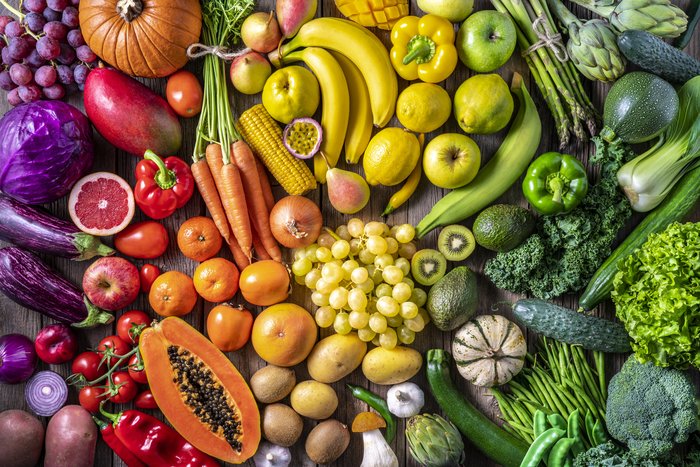This information is aimed at people who have been advised to lower the potassium in their diet by their healthcare team. It gives some initial advice to help lower your potassium levels. Only follow this advice if you have been advised that you need to lower your potassium.
Why do I need to lower my potassium levels?
When potassium is absorbed into the blood, it helps to keep your muscles and heart working properly.
Your kidneys help to control the amount of potassium in your blood.
Both low and high levels of potassium in the blood can lead to heart problems. Only follow this guidance if your healthcare team has advised you to.
How can I lower my potassium levels?
Medications
Always take any medications you have been prescribed to control the levels of potassium in your body.
Healthy bowels
Regular bowel movements can help prevent potassium from building up in the blood. If you are struggling with constipation, you may benefit from eating more fibre. Fibre is found in fruit, vegetables, wholegrains, beans, pulses, lentils, nuts and seeds. Your dietitian may also recommend a fibre supplement.
If you are still constipated, your healthcare team may prescribe some laxatives.
Blood sugar control (if you have diabetes)
High blood sugar levels are linked with high potassium levels. Talk to your dietitian or diabetes team for help with managing your blood sugar levels.
Dietary changes
Potassium is found in many foods and drinks, including processed foods such as fruit juice, crisps, chocolate and food containing potassium additives. You may not need to limit all high-potassium foods, but you may need to reduce your portion sizes, or how often you eat them.
A well-balanced diet contains a variety of foods from different food groups to make sure you get all the nutrients you need to stay as healthy as possible. It can be harder to get a good balance when you have been advised to limit the amount of some foods you eat. You may also find it difficult to follow this advice if you are already following a special diet for another reason, such as religious or ethical beliefs, or due to a medical condition.
A dietitian can give you personalised advice to help ensure you still get the healthy nutrients while managing your potassium intake.
What changes can I make to the food I eat to lower potassium?
Avoid potassium chloride as a salt replacement
Potassium chloride is sometimes used to replace some, or all, of the salt in a product, but it can increase your potassium levels.
Avoid any salt substitutes which list potassium chloride on the ingredients list, including SoLo®, Lo-Salt® or sodium-free salt.
Check processed foods such as crisps for potassium chloride on the ingredients list. You may be able to find a similar product which does not contain added potassium.
Processed foods are also often high in salt. Wherever possible, limit your intake of processed food and cook from scratch.
For seasoning, try pepper, fresh or dried herbs, spices, lemon juice, chilli or garlic.
Cooking methods to lower potassium
Boiling potatoes and other vegetables reduces their potassium content as some of the potassium leaks into the cooking water. Potatoes that have been par-boiled (partly cooked by boiling) can then be fried, roasted or added to casseroles.
Avoid using cooking water to make gravy, stocks or soups to keep out the extra potassium.
Soak dried pulses (beans, lentils, chickpeas) in plenty of water overnight, discard the water and boil. Alternatively, use tinned pulses, drain and rinse before adding to dishes.
Unless vegetables have been boiled, avoid steaming or microwaving vegetables as this keeps more of the potassium inside.
These simple steps can make a real difference lowering potassium in your diet.

Aim to eat at least five portions of fruit and vegetables a day
Choose low potassium food options: Fruit
| Lower potassium choices: | High potassium foods to reduce: |
|---|---|
apples |
bananas |
Choose low potassium food options: Vegetables
| Lower potassium choices: | High potassium foods to reduce: |
|---|---|
carrots |
beetroot |
Choose low potassium food options: Dairy and milk
Limit milk and yoghurt to a total of ½ pint (300ml) per day
| Lower potassium choices: | High potassium foods to reduce: |
|---|---|
dairy products such as cow’s milk and cow’s milk yoghurt |
condensed milk |
Choose low potassium food options: Protein
| Lower potassium choices: | High potassium foods to reduce: |
|---|---|
meat (chicken, turkey, pork, beef) |
ham and other deli meats |
Choose low potassium food options: Starchy foods
| Lower potassium choices: | High potassium foods to reduce: |
|---|---|
boiled potatoes or potatoes which have been par-boiled before roasting or frying |
jacket or baked potatoes |

Choose low potassium food options: Snacks
| Lower potassium choices: | High potassium foods to reduce: |
|---|---|
corn, rice, wheat or maize-based snacks |
potato, vegetable or lentil-based crisps and snacks |
Choose low potassium food options: Drinks
| Lower potassium choices: | High potassium drinks to reduce: |
|---|---|
tea |
coffee (limit to one cup a day) |
Lowering potassium: where can I find more information?
Please speak to your kidney dietitian for individual dietary advice, and for information about your specific dietary requirements.
- NHS Choices - Live Well
- Kidney Kitchen from Kidney Care UK: healthy, delicious multicultural food for every stage of kidney disease. Approved by kidney dietitians and enjoyed by everyone!
Lowering your potassium levels: download or order Kidney Care UK's information leaflet
You can download our Lowering your potassium levels leaflet for free.
You can also order a printed copy of Kidney Care UK’s Lowering your potassium levels to be sent to you in the post.

Publication date: 04/2024
Review date: 04/2027
This resource was produced according to PIF TICK standards. PIF TICK is the UK’s only assessed quality mark for print and online health and care information. Kidney Care UK is PIF TICK accredited.